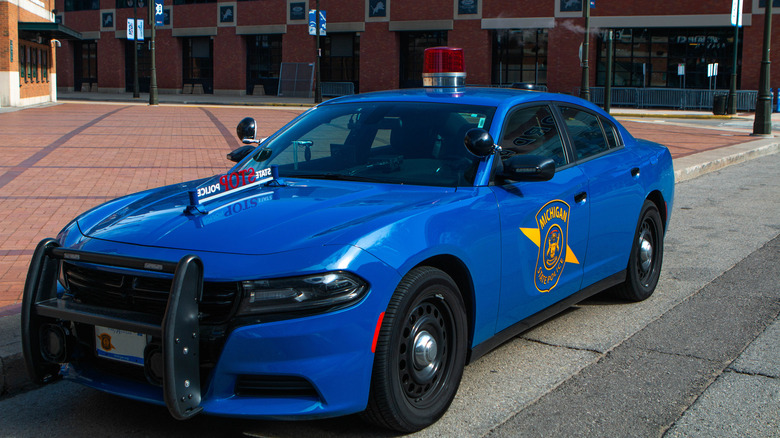Why Do Michigan State Police Cars Have A Single Red Light On The Roof?
Michigan became the twenty-sixth state in the Union in January 1837. It's the home of Detroit, the birthplace of the American automobile industry, where the likes of Henry Ford, the Dodge Brothers (who once worked for Ford), Ransom Olds, and Henry Leland turned it into "Motor City."
It took 80 years before it formed the Michigan State Constabulary to fill in for National Guard members who had been called overseas to fight in World War I. Two years later, the Constabulary was made into a permanent peacekeeping force, renamed the Michigan State Police. It would take another decade before the MSP started using marked patrol cars (1929), which at the time were equipped with fender-mounted red spotlights with the word "Stop" stenciled across the glass. This remained the status quo until the 1940s, when convex-shaped light fixtures with bulbs in the front and rear were attached to the roofs of each vehicle.
The singular, bright red rotating beacons — also known as "bubble" or "gumball" lights — first came into use in 1956 and, believe it or not, have never been replaced. The MSP is the only department in the United States that still uses this vintage design that was once commonly used atop police cars during the 1950s and 60s and thus has remained instantly recognizable to entire generations of Michiganders.
Why fix what isn't broken?
Tradition isn't the only reason why the Michigan State Police has kept the gumball lights all these years, although they do have a penchant for tradition, considering they also have a "STOP" sign attached to the hoods of their patrol cars. Each year, the MSP conducts an evaluation and puts the latest police vehicles through an extensive testing procedure to see if they're any better than the previous year's model and would be more suitable for use by the department.
Vehicles equipped with modern overhead light bars actually accelerate slower than those with a single overhead beacon. Because the rounded shape of the bubble light is more aerodynamic and causes less drag than a full width of the roof lightbar, vehicles get better gas mileage.
The MSP beacons were updated in 2009 with LEDs (Light Emitting Diodes) that are significantly brighter than the previous generation's old-school bulbs and fit within the original housing. They were upgraded again in 2016 with kits that used 12 light heads (with nine LED bulbs per head) for a total of 108 lights (all of which can last for 100,000 hours) per beacon, which ironically is much more than that a standard modern light bar contains.
In 2023, after getting feedback from officers, the MSP expanded the functionality of the beacon to equal what the light bars are capable of doing by including things like 360-degree scene, front takedown, alley, and reverse lighting; synchronized flash patterns, and increased the total number LEDs to 144 (from 108). Tradition is alive and well in Michigan, but it doesn't stand in the way of innovation.

